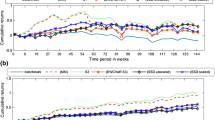Abstract
In this article, an enhanced indexing (EI) model is put forward for portfolio selection to optimize a specific quantile of the return distribution of the benchmark index + alpha return combined with the conditional value at risk to control the downside risk in the portfolio. Constraints on short-selling and portfolio rebalancing with the transaction and holding costs are built in the models as a means of integrating real-life functionalities. The proposed models are linear or mixed integer linear programs. The out-of-sample performance comparison of the proposed model without short-selling with the benchmark index and an existing quantile based EI model on the data sets of several markets across the globe exhibit higher average returns and mean-risk ratios like Sharpe ratio and STARR, thus fulfilling the objective of EI. We also study the out-of-sample performance of our model with short-selling during financial meltdown periods.



Similar content being viewed by others
Notes
We did not include indtrack7.txt and indtrack8.txt from the Beasley OR library (Canakgoz and Beasley 2009) because the data sets in the two tracks are large in size leading to a computational challenge in applying the rolling window analysis for solving the mixed integer model by Mezali and Beasley (2013) used in comparison in the empirical analysis.
The t-statistics used in t-test is \(\frac{\mu _{s_1}-\mu _{s_2}}{\sigma _{s_1-s_2}}\), where \(\mu _{s_1}, \;\mu _{s_2}\) are the average returns from strategy \(s_1\) and \(s_2\) and \(\sigma _{s_1-s_2}\) is the standard deviation of the difference of returns from strategy \(s_1\) and \(s_2\).
References
Ahmed, P., and S. Nanda. 2005. Performance of enhanced index and quantitative equity funds. Financial Review 40 (4): 459–479.
Allen, D.E., R. Powell, and A. Singh. 2011. Quantile regression as a tool for portfolio investment decisions during times of financial distress. Annals of Financial Economics 6 (01): 1150003.
Arnott, R.D., and W.H. Wagner. 1990. The measurement and control of trading costs. Financial Analysts Journal 46 (6): 73–80.
Bergling, F. 2018. Applications of quantiles in portfolio management. https://uu.diva-portal.org/smash/get/diva2:1228679/FULLTEXT01.pdf.
Black, F., and R. Litterman. 1992. Global portfolio optimization. Financial Analysts Journal 48 (5): 28–43.
Brandt, M.W., P. Santa-Clara, and R. Valkanov. 2009. Parametric portfolio policies: exploiting characteristics in the cross-section of equity returns. The Review of Financial Studies 22 (9): 3411–3447.
Bruni, R., F. Cesarone, A. Scozzari, and F. Tardella. 2015. A linear risk-return model for enhanced indexation in portfolio optimization. OR Spectrum 37 (3): 735–759.
Businessinsider article. 2019. ’Big Short’ investor Michael Burry is calling passive investment a ’Bubble.’ he’s not the only finance luminary sounding the alarm. https://www.businessinsider.in/miscellaneous/big- short-investor-michael-burry-is-calling-passive-investment-a-bubble-hes-not-the-only-finance- luminary-sounding-the-alarm-/slidelist/70899463.cms
Canakgoz, N.A., and J.E. Beasley. 2009. Mixed-integer programming approaches for index tracking and enhanced indexation. European Journal of Operational Research 196 (1): 384–399.
Chavez-Bedoya, L., and J.R. Birge. 2014. Index tracking and enhanced indexation using a parametric approach. Journal of Economics Finance and Administrative Science 19 (36): 19–44.
De Paulo, W.L., E.M. De Oliveira, and O.L. do Valle-Costa. 2016. Enhanced index tracking optimal portfolio selection. Finance Research Letters 16: 93–102.
Economic Sciences Prize Committee of the Royal Swedish Academy of Sciences. 2013. Economic sciences prize committee of the Royal Swedish Academy of Sciences, understanding asset prices. https://www.nobelprize.org/uploads/2018/06/advanced-economicsciences2013.pdf
Filippi, C., G. Guastaroba, and M. Speranza. 2016. A heuristic framework for the bi-objective enhanced index tracking problem. Omega 65: 122–137.
Goel, A., A. Sharma, and A. Mehra. 2018. Index tracking and enhanced indexing using mixed conditional value-at-risk. Journal of Computational and Applied Mathematics 335: 361–380.
Guastaroba, G., R. Mansini, M.G. Speranza, and W. Ogryczak. 2016. Enhanced index tracking with cvar-based measures. https://www.semanticscholar.org/paper/Enhanced-Index-Tracking-with-CVaR-Based-Measures-Guastaroba-Mansini/229ef523cc08a5557ab254bb0d9b4b7ffff6b261
Guastaroba, G., R. Mansini, W. Ogryczak, and M.G. Speranza. 2016. Linear programming models based on omega ratio for the enhanced index tracking problem. European Journal of Operational Research 251 (3): 938–956.
Haugom, E., R. Ray, C.J. Ullrich, S. Veka, and S. Westgaard. 2016. A parsimonious quantile regression model to forecast day-ahead value-at-risk. Finance Research Letters 16: 196–207.
Keating, C., and W.F. Shadwick. 2002. A universal performance measure. Journal of performance measurement 6 (3): 59–84.
Koenker, R., and G. Bassett Jr. 1978. Regression quantiles. Econometrica 46: 33–50.
Krokhmal, P., J. Palmquist, and S. Uryasev. 2002. Portfolio optimization with conditional value-at-risk objective and constraints. Journal of Risk 4: 43–68.
Ma, L., and L. Pohlman. 2008. Return forecasts and optimal portfolio construction: a quantile regression approach. The European Journal of Finance 14 (5): 409–425.
Mansini, R., W. Ogryczak, and M.G. Speranza. 2007. Conditional value at risk and related linear programming models for portfolio optimization. Annals of Operations Research 152 (1): 227–256.
Meade, N., and J.E. Beasley. 2011. Detection of momentum effects using an index out-performance strategy. Quantitative Finance 11 (2): 313–326.
Mezali, H., and J. Beasley. 2013. Quantile regression for index tracking and enhanced indexation. Journal of the Operational Research Society 64 (11): 1676–1692.
Oberoi, S., M.B. Girach, and S.P. Chakrabarty. 2020. Can robust optimization offer improved portfolio performance? An empirical study of Indian market. Journal of Quantitative Economics 18 (3): 611–630.
Rao, Z.U.R., T. Ahsan, M.Z. Tauni, and M. Umar. 2018. Performance and persistence in performance of actively managed Chinese equity funds. Journal of Quantitative Economics 16 (3): 727–747.
Rockafellar, R.T., and S. Uryasev. 2000. Optimization of conditional value-at-risk. Journal of Risk 2: 21–42.
Rockafellar, R.T., and S. Uryasev. 2002. Conditional value-at-risk for general loss distributions. Journal of Banking & Finance 26 (7): 1443–1471.
Roman, D., G. Mitra, and V. Zverovich. 2013. Enhanced indexation based on second-order stochastic dominance. European Journal of Operational Research 228 (1): 273–281.
Sant’Anna, L.R., T.P. Filomena, and J.F. Caldeira. 2017. Index tracking and enhanced indexing using cointegration and correlation with endogenous portfolio selection. The Quarterly Review of Economics and Finance 65: 146–157.
Sehgal, R., and A. Mehra. 2019. Enhanced indexing using weighted conditional value at risk. Annals of Operations Research 280: 1–30.
Sharma, A., S. Agrawal, and A. Mehra. 2017. Enhanced indexing for risk averse investors using relaxed second order stochastic dominance. Optimization and Engineering 18 (2): 407–442.
Strub, O., and P. Baumann. 2018. Optimal construction and rebalancing of index-tracking portfolios. European Journal of Operational Research 264 (1): 370–387.
Woodside-Oriakhi, M., C. Lucas, and J.E. Beasley. 2013. Portfolio rebalancing with an investment horizon and transaction costs. Omega 41 (2): 406–420.
Yang, T., and X. Huang. 2021. Two new mean-variance enhanced index tracking models based on uncertainty theory. The North American Journal of Economics and Finance 59: 101622.
Yu, J.R., and W.Y. Lee. 2011. Portfolio rebalancing model using multiple criteria. European Journal of Operational Research 209 (2): 166–175.
Yu, J.R., W.J.P. Chiou, and D.R. Mu. 2015. A linearized value-at-risk model with transaction costs and short selling. European Journal of Operational Research 247 (3): 872–878.
Yu, J.R., W.J.P. Chiou, and R.T. Liu. 2017. Incorporating transaction costs, weighting management, and floating required return in robust portfolios. Computers & Industrial Engineering 109: 48–58.
Zhao, Z., F. Xu, M. Wang, and C.Y. Zhang. 2019. A sparse enhanced indexation model with norm and its alternating quadratic penalty method. Journal of the Operational Research Society 70 (3): 433–445.
Zhu, S., and M. Fukushima. 2009. Worst-case conditional value-at-risk with application to robust portfolio management. Operations Research 57 (5): 1155–1168.
Author information
Authors and Affiliations
Corresponding author
Additional information
Publisher's Note
Springer Nature remains neutral with regard to jurisdictional claims in published maps and institutional affiliations.
Rights and permissions
Springer Nature or its licensor (e.g. a society or other partner) holds exclusive rights to this article under a publishing agreement with the author(s) or other rightsholder(s); author self-archiving of the accepted manuscript version of this article is solely governed by the terms of such publishing agreement and applicable law.
About this article
Cite this article
Sehgal, R., Mehra, A. Quantile Regression Based Enhanced Indexing with Portfolio Rebalancing. J. Quant. Econ. 21, 721–742 (2023). https://doi.org/10.1007/s40953-023-00355-w
Accepted:
Published:
Issue Date:
DOI: https://doi.org/10.1007/s40953-023-00355-w




